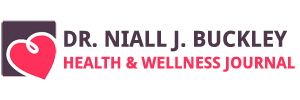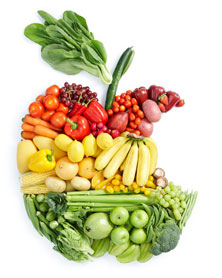
Our journey to explore the current science of Anti-Aging will take us into (and through) a variety of subjects. Some of the newer topics will explore and examine such subjects as hormone optimization. Any wellness program, however, must start with the three bases; nutrition, exercise and relaxation.
Today’s Journal post will begin to address the first of these three – nutrition.
Food is an important part of a balanced diet – Fran Lebowitz
Please allow me to introduce this topic with a little story from my own experience.

Trinity College, Dublin
Shortly after completing a year of post graduate training at Trinity College, Dublin, I left Ireland, age 28 to take up a family practice job in rural Newfoundland, Canada. My young wife and 20 month old son in tow, we landed (May 30) in Gander, Newfoundland. Wearing my dad’s hand me down sheepskin coat and winter underthings, dragging our worldly possessions along in six large suitcases, we struggled our way to immigration in the (unseasonably) sweltering heat (Gander International in those days consisted of a group of metal Quonset huts and the outside temperature was 32°C!).
On the day I landed I weighed 146 lbs and stood 5’9”.
Less than a week later, with my Canadian papers in order, I set up practice in a hamlet on the south coast of Newfoundland’s Avalon Peninsula. Now I’ve got to tell you, the patients and neighbours looked after us; codfish, moose, caribou, rabbit and a steady stream of homemade bread came to our door! Potatoes, carrots, parsnips and cabbage came to the office. We ate well! At least, we ate real food and a whole lot of it, everyday, for five years. At about this time I felt the need to take our first “down south” vacation. Off to the Caribbean we went, a grand time was had and when we got back home, well, the vacation photos arrived.

I will spare you the details (truly), this boy was no longer lean. Well, I decided that this situation would not do, I placed myself (timidly) on the office scale, 190 lbs.! Next evening, I came home from work, I laced on my old sneakers and hopped in the car. I measured off 1.5 miles up the street, got out and with a spray bomb marked the sidewalk.
That evening I jogged to the spray mark and back for the very first time. My wife’s initial response when I straggled in the front door was to muffle a scream and run away. I will continue this story in my upcoming Journal post, entitled “a primer on exercise”.

Why is a healthy diet so important?
As the green plant needs the warm sun to allow it to generate energy, we humans need to eat to enable our bodies to function (hopefully, optimally). We need to be aware of what it is that we are eating (and drinking). We are surrounded by toxins in the air that we breathe (car exhaust, tobacco smoke, industrial pollutants) and other nasties such as radiation and preservatives in our foods.
All of these things generate molecules (oxidants and free radicals). A healthy diet should provide the necessary nutrients to maintain and repair the (many) body systems and to neutralize the toxins that we are taking into our bodies. Our hectic, stressful lifestyles also reduce our production of our own anti-oxidants. Consumption of fresh, healthy foods is our best ally as we attempt to live an Anti-Aging lifestyle.
What are your main goals when selecting the type of healthy diet that best works for you?
You need to strive for a lean/strong physique. I recommend five measurement tools to determine where you, personally stand as you begin your journey to lean and strong.
1. What is your BMI?
BMI or Body Mass Index is derived from a measure of weight adjusted for height; (divide your weight in pounds by your height in inches, divide that number by your height in inches, and multiply that number by 703). You can look up the BMI# on a BMI chart or you can use a BMI calculator like the one provided here. The goal is to keep your BMI less than 25.
Higher BMI’s are associated with increased incidence of disease; heart disease, type 2 diabetes and cancer.
| BODY MASS INDEX | WHO CLASSIFICATION |
| < 18.5 | UNDERWEIGHT |
| 18.5 – 24.9 | HEALTY WEIGHT |
| 25.0 – 29.9 | OVERWEIGHT |
| 30+ | OBESE |
2. Waist to Hip Circumference Ratio
People who store fat around waist and chest are said to be apple shaped. Those who store fat around hips and thighs are pear shaped. Fat that accumulates around the waist is associated with higher health risks than that which accumulates around the hips.
More simply though, your waist size, in and of itself will tell you the tale. If you are up 2, 3 or 4 inches from your college days, you should examine your eating habits and re-evaluate your exercise regimen.
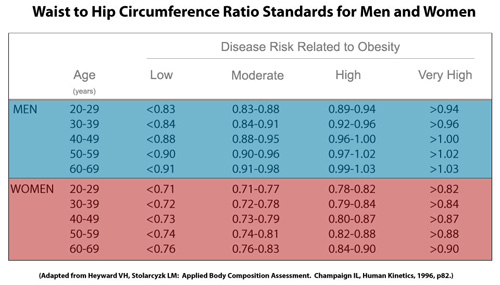

3. Body Composition Measurement
Understanding your body composition readings. This analysis includes a number of measurements providing an in-depth look at your body composition. You and your health professional can use this analysis to assess aspects of your current health. The product I use is really simple and provides useful information. The parameters provided are; BMR (Basal Metabolic Rate), Impedance, Fat Mass, Free Fat Mass and TBW (Total Body Water).
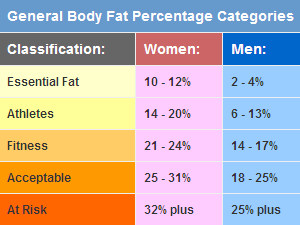
4. Cardiovascular Risk Measurement
If you are healthy and without diabetes, the Reynolds Risk Score is designed to predict your risk of having a future heart attack, stroke or other major heart disease in the next 10 years.
In addition to your age, blood pressure, cholesterol levels and whether you currently smoke, the Reynolds Risk Score uses information from two other risk factors, a blood test called hsCRP (a measure of inflammation) and whether or not either of your parents had a heart attack before they reached age 60 (a measure of genetic risk).
See the Reynolds Risk Score Calculator
5. Cholesterol Profile
(Also fasting blood sugar level, hsCRP and HgA1c)
Lipid profile is a panel of blood tests that serves as an initial broad medical screening tool for abnormalities in lipids, such as cholesterol and triglycerides. The results help to determine risks for cardiovascular (and other) disease.
To determine these levels you will need to get blood work done.
Ask your doctor to order them.
So, let’s do this homework. I will help you if you run into any problems.
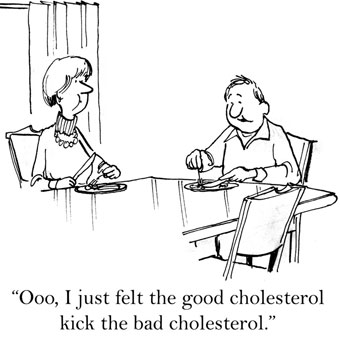
My next Journal post will explore the diet options open to you and the scientific reasons behind those recommended choices.
Ask a Question?
I will be happy to answer any questions that you may have, related to this Journal article. I will post my answers to the 10 most frequently asked questions on the website.
For More Information
See: Nutrition – Recommended Reading & Links
Please take a moment to Subscribe to my free Health & Wellness Newsletter to receive monthly updates and exclusive content for members.
